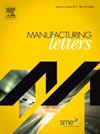采用分层与堆叠方法制造电池互连多层超声接头的比较
IF 2
Q3 ENGINEERING, MANUFACTURING
引用次数: 0
摘要
本文研究了两种不同的方法,即“分层方法”和“堆叠方法”,用于使用超声波金属焊接(USMW)创建多层接头,特别适用于电动汽车(EV)电池互连。一个这样的要求是为袋电池创建多个连接母线接头。采用厚度分别为0.25 mm和1mm的铜(Cu)片和铝(Al)母线制作多层异型接头。通过分层技术制造的5Cu卡箍到1Al母线接头的机械强度(~ 237 N)分别是3Cu到1Al母线和2Cu到1Al母线组合的3.78倍和2.47倍(因为使用堆叠方法不可能实现超过3个Cu卡箍到母线的焊接),同时需要减少热量产生和夹紧压力。本文章由计算机程序翻译,如有差异,请以英文原文为准。

A Comparison of Multi-Layered Ultrasonic Joints Fabrication using Layer-Wise vs Stacked Approaches for Battery Interconnects
This paper investigates two different approaches, namely the ‘Layer-wise Approach’ and ‘Stacked Approach’, employed to create multi-layered joints using ultrasonic metal welding (USMW), especially useful for electric vehicle (EV) battery interconnects. One such requirement is for the pouch cell to create multiple tabs to busbar joints. Multi-layer dissimilar joints were made using copper (Cu) tabs and aluminum (Al) busbars of thickness 0.25 mm and 1 mm, respectively. The 5Cu tabs to 1Al busbar joint created by layer-wise techniques exhibited 3.78 and 2.47 times more mechanical strength (∼237 N) than 3Cu to 1Al busbar and 2Cu to 1Al busbar combinations (as more than 3 Cu tabs to busbar welding was not possible using stacked approach), respectively, while necessitating reduced heat generation and clamping pressure.
求助全文
通过发布文献求助,成功后即可免费获取论文全文。
去求助
来源期刊

Manufacturing Letters
Engineering-Industrial and Manufacturing Engineering
CiteScore
4.20
自引率
5.10%
发文量
192
审稿时长
60 days
 求助内容:
求助内容: 应助结果提醒方式:
应助结果提醒方式:


